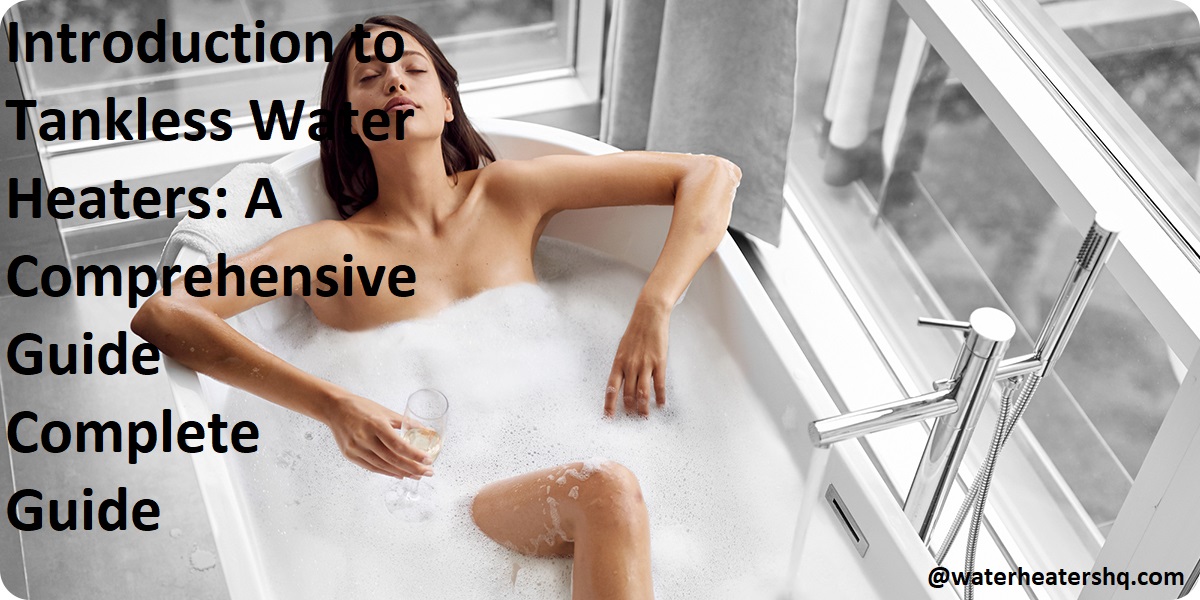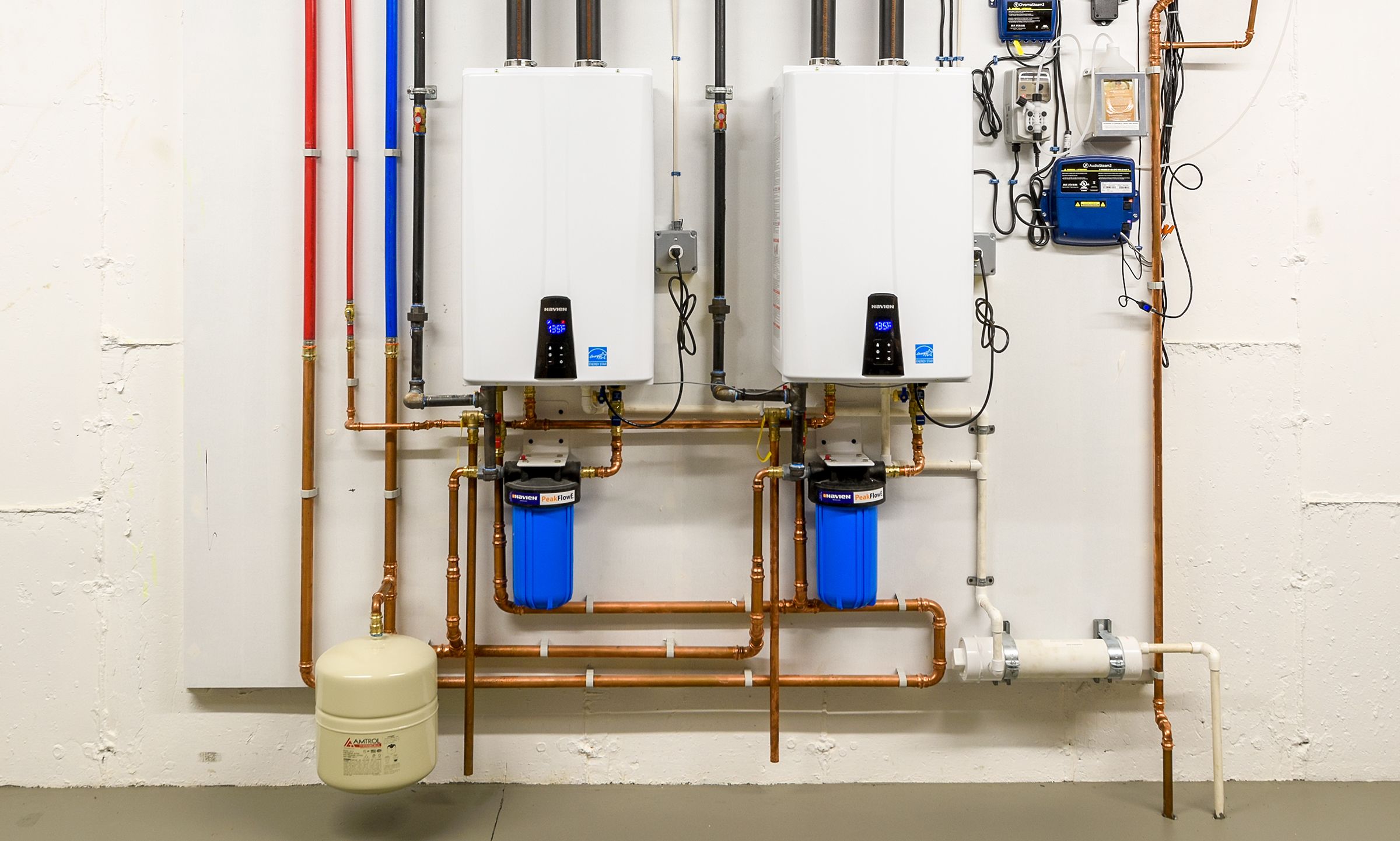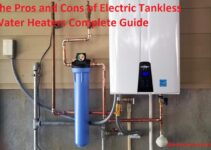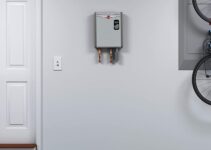Are you looking to upgrade your water heater, but confused on which option is the right fit for you? Look no further!
This comprehensive guide will help you understand the advantages of tankless water heaters and how they can provide a cost-effective solution for your hot water needs. From installation to maintenance and costs, let’s dig into the world of tankless water heating today!
Tankless water heaters are an energy-efficient alternative to traditional water heaters. Instead of continuously heating and storing large amounts of water, tankless systems instantaneously heat up the water as it is needed and requires no storage tanks. This type of system utilizes 30-50 percent less energy than a standard tank heater, allowing for savings on monthly energy bills and also a reduced carbon footprint.
Tankless systems are ideal for homes with high demand for hot water and require very little maintenance. In this guide, we will provide you with a comprehensive overview on tankless water heaters — from the pros and cons to sizing information — so that you can make an educated decision when selecting one for your home.
Explanation of Tankless Water Heaters
Tankless Water Heaters are becoming increasingly popular due to their efficiency and cost savings compared to traditional models. Tankless Water Heaters provide hot water on demand, saving energy and reducing costs by operating only when hot water is needed. This means no more running out of hot water or waiting for the tank to fill up. Instead, a small, powerful burner or heating element is activated as soon as you turn on the tap – delivering highly efficient, consistent hot water throughout your home without wasting energy heating up a large tank that isn’t in use. Not only are they energy efficient but they also require less maintenance and provide potentially lower operating costs over the life of the appliance.
Tankless Water Heaters can be powered by either electricity or natural gas or propane and come in different sizes and configurations to best fit your specific needs. Flow rate is an important factor when considering a tankless unit – they are not able to produce large quantities of instant hot water since it takes time for them to heat-up the incoming water up to its set temperature. Proper sizing helps ensure that you get the amount of hot water that meets your desired flow rate needs for optimal performance in any season. Most systems come pre-set at 120°F, but for safety reasons many local building codes may require installing a system set at a lower (suggested) temperature of 110°F or less based on the location, appliance type and other factors.
Tankless Water Heaters also require venting, so be sure to check with your local building code regulatons before installing one!

Advantages and Disadvantages of Tankless Water Heaters
Tankless, or demand-type, water heaters are an efficient method of providing hot water to your home as needed. One of the major advantages of a tankless water heater is that they provide an unlimited amount of hot water since they hold no gallons in a storage tank, unlike traditional hot water heaters. This can save you time and money in monthly energy bills, not to mention the convenience.
However, there are also some drawbacks to installing a tankless system in your home. Namely, initial startup costs for tankless systems tend to be high due to the cost of materials and labor. Additionally, you need significant space for installation if you’re replacing an existing traditional unit – long runs for venting may also be required depending on where your hot water connection is located with respect to the incoming gases from your hot water appliance. Other possible drawbacks include insufficient pressure from multiple outlets being used at the same time and lagging response times while waiting for hot water while taking showers or completing household tasks that require considerable amounts of warm or hot temperatures such as washing dishes or clothes.
How Tankless Water Heaters Work
Before you choose a tankless water heater, it is important to understand the basics of how these types of heating systems work. Tankless water heaters are energy-efficient appliances that provide hot water when needed, without having to keep a supply of hot water in a large tank. This eliminates the need for storing and heating extra gallons of hot water, resulting in considerable savings on your monthly energy bill.
Tankless water heaters are designed using advanced technologies, allowing them to instantly provide heated water on demand. These systems allow you to customize your home’s hot water usage and temperature settings because they adjust their operations based on the flow rate and amount of hot fluids used.
When you turn on a faucet or begin running the dishwasher, cold water enters the tankless system through an inlet pipe or hose. Once inside, the cold fluid is distributed through an inlet housing before it reaches an exchanger coil located at the bottom of the device. The exchanger coil is where combustion occurs; when it heats up to its maximum temperature setting – typically around 140F-150F – gases ignite and burn, creating warmth that quickly reaches much higher temperatures as it moves from coil to coil throughout the device.
When this heated fluid returns from the exchanger coils through outlet pipes, it passes into another housing known as a secondary/heat exchanger section which further increases its temperature before exiting outwards through another hose or pipe as hot/warm fluids destined for use around your home – from your daily baths and showers all the way down to carwashing duties!
Comparison with Traditional Water Heaters
Traditional tank-style water heaters are considered the workhorse of the home for hot water applications. They are reliable, dependable and generally last between 8-12 years.
Tankless water heaters have enjoyed a huge resurgence in popularity due to their energy efficiency, industry advances in product design and their proven track record of consumer satisfaction when properly installed. So how do they compare?
Tankless water heaters, also known as on-demand, instant or whole-house water heaters offer an alternate means of hot water delivery to your taps. They differ from traditional tank style models by providing an almost continuous supply – no need to run out of hot water! The distinguishing feature is that instead of continuously heating and re-heating a tank full of stored hot water, tankless units rapidly heat up cold incoming household water whenever a hot tap is turned on. They are designed to call for fuel only when it’s needed so no heated “standby” losses occur like with traditional tanks. This ultimately leads to significant energy savings and cost reductions for home owners over time – it’s the primary reason behind the trend!
Types of Tankless Water Heaters
Tankless water heaters are available in two basic types: gas and electric. Each type has its advantages, so it’s important to consider all your options when purchasing a tankless system.
Gas Tankless Water Heaters: These systems run on natural gas or propane and are ideal for larger dwellings that have an existing gas line or require greater hot water capacity. They tend to be less expensive than electric models, provide faster hot water delivery, and can easily provide enough hot water simultaneous use from several applications (e.g., shower and washing machine).
Electric Tankless Water Heaters: Available in both point-of-use (POU) and whole-house (WHO) models, electric tankless systems are gaining popularity due to their ease of installation, efficiency (e.g., no chimney flue required as with a gas model), low operating costs, and smaller size/space requirements compared to traditional storage tank models. They are typically more expensive than gas versions but use less electricity than a standard heater over time due to the lack of standby energy loss associated with tanks. Electric POU models can be used wherever an individual faucet needs water heating, while WHO systems provide heated water throughout a building at the same temperature–eliminating the need for multiple small system installations around the house.
Components of Tankless Water Heaters
Tankless water heaters are composed of several components that work together to efficiently provide hot water on demand. The core components of the tankless water heater include the gas burner, heat exchanger, control circuit board and hot-water outlet. Other components such as flow switches and thermostats monitor the temperature and flow rate of the incoming water.
The gas burner has a number of components, including the fan motor, venturi tube and spark igniter. The fan motor regulates the speed of air intake in order to control the flame intensity and heat output. The venturi tube helps draw an even amount of air into the burner for optimal combustion. The spark igniter is used to light up the gas when it’s needed; however, some models may have an electronic ignition in which case no separate igniter will be needed.
The heat exchanger is designed to transfer or exchange hot inside air with colder outside air using copper tubes or finned coils which are fitted around a central chamber located inside the unit. It heats up quickly due to its high surface area exposed to fire inside the combustion chamber, enabling it to act as a medium between the inlet cold water and outlet heated water pipes within a very short time frame without significant losses except what is lost through thermal insulation inefficiencies or pipe wall convection cooling.
The control circuit board monitors incoming water temperature and adjusts it according to your needs. It automatically shuts off when temperatures exceed safe levels for you and your home safety measures are in place for when problems arise such as interruption in supply from natural disasters or other human error sources which may cause unsafely high temperatures due to malfunctioning thermostats or overloaded breaker switches for instance.
Finally, there is an outlet valve at one end that converts cold incoming liquid into hot outgoing liquid through a special heating process generated by tankless water heater hence delivering boiling hot water from it on demand.
Maintenance and Repairs of Tankless Water Heaters
Regular upkeep and maintenance of your tankless water heater is essential to ensure long-lasting performance. The following steps can be followed as a guide when it comes to routine maintenance of your unit:
- Inspect the air intake filter every 6 months or so and replace if needed. Ensure that it is clean and unobstructed for better air flow through your unit.
- Remember to check for signs of condensation on the inside of your heater’s casing, as this could lead to rusting and eventual malfunctioning of the unit. If so, contact a professional service at service@[company].com immediately for repairs.
- Flush out accumulated deposits from your tankless water heater’s pipes and heat exchanger regularly – every couple of months – in order to keep them functioning properly and clear up any circulating debris or sediment that might be clogging it up over time. Make sure that all shut-off valves are in good working order too, as these will be what allows hot water to travel through the pipes without interruption when needed. Lastly, if possible, check out the incoming cold water line for any leaks or blockages which may leave you with inconsistent temperatures during operation. Services at service@ [company].com can be called upon if help is needed with this step too!
- Lastly, always remember to monitor you meter levels closely on a regular basis – monthly or quarterly is ideal – since this could indicate dangerous Ultra Low Emission (ULE) levels which could harmfully affect both you and your family’s health if not addressed in some way soon enough.

Regular Maintenance
Regular maintenance is essential to ensure the efficient operation of a tankless water heater. To prevent corrosion, mineral build-up and ensure optimal performance, it’s important to regularly flush the tankless unit using an appropriate cleaning solution. Regular maintenance will also help to limit repair costs and extend its overall lifespan.
It is recommended that you thoroughly clean your tankless water heater once a year in addition to performing simple quarterly inspections. During an annual cleaning process, a specialized cleaning solution is mixed with water and run through the entire unit; this should effectively remove all debris, lime deposits and minerals from the pipes, boiler plate and heat exchanger of your unit. If a more deep cleansing is needed for heavily used units or for locations with hard water problems, consider adding descaling kits to intensify the results of your regularly scheduled maintenance routine.
Common Issues and Repairs
Common issues and repairs associated with tankless water heaters can be divided into two main categories: maintenance and troubleshooting. Regular maintenance is essential to ensure optimal performance, while troubleshooting can help identify the causes of malfunctioning equipment.
Maintenance: To maintain your tankless water heater, it is recommended that you periodically check the temperature/pressure relief valve and flue piping for leakage. In addition, you should inspect your burner assembly or heat exchanger for debris build up or corrosion on a regular basis. Also, it is important to regularly flush your unit to remove sediment that can accumulate over time. For more detailed instructions regarding maintenance of your tankless water heater, please consult the manufacturer’s user manual or contact an experienced technician.
Troubleshooting: If you encounter any problems with your tankless water heater, it is best to first consult with a qualified technician. Service technicians have experience both in identifying the cause of issues and in resolving them safely and efficiently. However, before you call a technician there are few things that you should attempt on your own if possible, including resetting circuit breakers as well as checking fuses/breakers in fuse boxes/panels (consult manufacturer’s user manual if unfamiliar). In addition, make sure that all connections between components are secure and no valves have been inadvertently closed or obstructions removed from air vents when attempting repairs on the system yourself.
Troubleshooting Tips
Before calling a technician for advice, you may be able to resolve your tankless water heater problem yourself. Here are some troubleshooting tips to help you get started:
- Check the power supply first. Make sure that it is still on and connected properly. If it has been off for an extended period of time, you may need to reset the water heater; refer to your user manual for instructions.
- Check the thermostat, as this can affect the heater’s efficiency, and make sure that all valves are in the open position and there are no obstructions in the outlet pipe (this could cause low water pressure).
- If your unit is not heating water or is not producing enough hot water for long periods of time, check for mineral build up in your pipes or sediment buildup inside the tankless water heater heat exchanger. Clean any accumulated materials using a professional brand cleaner specifically designed for cleaning tankless heaters.
- If you suspect a defective component or faulty valve on your tankless heater, turn off all electrical and shut off all valves before replacing or repairing anything – depending on what needs to be done, call a professional technician for help.

Conclusion
In conclusion, tankless water heaters offer many benefits to homeowners over traditional tank-based water heaters. These advanced devices are incredibly energy-efficient and require less maintenance than standard water heating systems. Tankless units also offer a constant supply of hot water and last longer than their tank counterparts.
Homeowners should consider their budget, lifestyle, and home size when shopping for a new water heater. If a tankless system sounds like the perfect fit for your home, make sure to research all of the models available in-depth before committing to a purchase. This way, you will have peace of mind that you have made the best decision for your home.
FAQ’S
What is the introduction of tankless water heater?
A tankless water heater is a type of water heating system that heats water on-demand without the need for a storage tank.
What are the different types of tankless water heaters?
The two main types of tankless water heaters are electric tankless water heaters and gas-fired tankless water heaters.
What are the main parts of a tankless water heater?
The main parts of a tankless water heater include the heat exchanger, burner or heating element, control panel, and sensors.
What is the disadvantage of tankless water heater?
One disadvantage of a tankless water heater is that it may have a higher upfront cost compared to a traditional tank water heater. Additionally, a single tankless unit may not be able to provide enough hot water for larger households with high hot water demands.
What is the main benefit of a tankless water heater?
The main benefit of a tankless water heater is that it provides hot water on-demand, which can result in energy savings and a more consistent supply of hot water.
What is the purpose of a tankless water heater?
The purpose of a tankless water heater is to provide hot water on-demand without the need for a storage tank.
What are the two types of tankless water heaters?
The two types of tankless water heaters are electric tankless water heaters and gas-fired tankless water heaters.
What is a tankless water heater called?
A tankless water heater is sometimes also called an on-demand water heater or instantaneous water heater.
What’s the difference between water heater and tankless water heater?
A traditional water heater stores and heats water in a large tank, while a tankless water heater heats water on-demand without the need for a storage tank.
What is the brief description of water heater?
A water heater is a device that heats and stores hot water for use in a home or building. It typically consists of a large storage tank that is heated by an electric or gas-powered burner.
See Also:
- Best power vent water heater
- Best propane tankless water heater
- Best solar water heater
- Best tankless water heater
- Best under sink water heater


